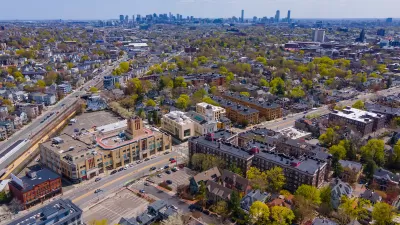Charles Marohn proposes height limits as a catalyst for development. Yes, you read that correctly.

Marohn's argument begins with the example of Sarasota, Florida, where the cost of land is a barrier to small-scale, incremental development. Marohn explains that despite the demand for growth, cities artificially inflate the cost of land by allowing high-density, tall projects next to vacant lots and strip malls. The effect of so much helter-skelter development, according to Marohn: "A small number of people will sell their vacant lots at a premium. The development on these lots will absorb the latent demand. Everyone else with a vacant lot will wind up with nothing – no demand, no sale – and, in the interim, any incremental development will be stifled, along with any naturally-occurring redevelopment (non-subsidized)."
After noting that before the "suburban experiment" development occurred incrementally: "Cities matured by moving to the next plateau of financial value, growing incrementally up, incrementally out and becoming incrementally more intense." To mimic a more natural process of incrementalism, Marohn suggests height restrictions as a regulatory mechanism preferable to zoning codes: "I would allow the next increment of development, but nothing more…. Something simple: The maximum building height shall be two stories or 1.5 times the average height of the directly adjacent buildings, whichever is greater."
*This post was updated 11/3/2014 with the proper spelling of the author's name.
FULL STORY: A Case for Height Restrictions

Alabama: Trump Terminates Settlements for Black Communities Harmed By Raw Sewage
Trump deemed the landmark civil rights agreement “illegal DEI and environmental justice policy.”

Planetizen Federal Action Tracker
A weekly monitor of how Trump’s orders and actions are impacting planners and planning in America.

The 120 Year Old Tiny Home Villages That Sheltered San Francisco’s Earthquake Refugees
More than a century ago, San Francisco mobilized to house thousands of residents displaced by the 1906 earthquake. Could their strategy offer a model for the present?

Ken Jennings Launches Transit Web Series
The Jeopardy champ wants you to ride public transit.

BLM To Rescind Public Lands Rule
The change will downgrade conservation, once again putting federal land at risk for mining and other extractive uses.

Indy Neighborhood Group Builds Temporary Multi-Use Path
Community members, aided in part by funding from the city, repurposed a vehicle lane to create a protected bike and pedestrian path for the summer season.
Urban Design for Planners 1: Software Tools
This six-course series explores essential urban design concepts using open source software and equips planners with the tools they need to participate fully in the urban design process.
Planning for Universal Design
Learn the tools for implementing Universal Design in planning regulations.
Clanton & Associates, Inc.
Jessamine County Fiscal Court
Institute for Housing and Urban Development Studies (IHS)
City of Grandview
Harvard GSD Executive Education
Toledo-Lucas County Plan Commissions
Salt Lake City
NYU Wagner Graduate School of Public Service





























